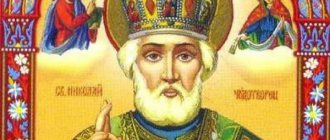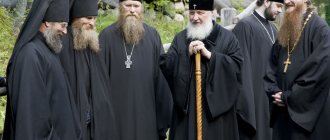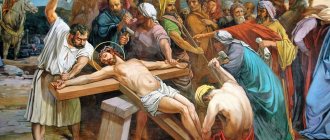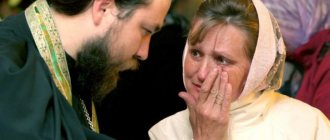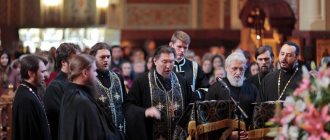Female priesthood
Ordination of women
Short version
Rod: Equality of women in the Church
manifestation of the anthropological revolution with the aim of realizing the myth of equality of unequals. An extreme version of the ideologically motivated struggle for equal rights for women in the Church. Work to promote the female priesthood in the Orthodox Church is carried out with the ideological and financial support of the ecumenical movement.
“In the patristic tradition there are no specific instructions of an anthropological, liturgical or historical nature, on the basis of which one could talk about the possibility of introducing a female priesthood in the Orthodox Church. This problem is not rooted in church tradition, but is associated with the development of modern feminist ideas that pursue the destruction of sexual dualism and the equalization of the social roles of men and women, which is already catastrophically affecting the state of the modern family.”[1].
stages
The question of the female priesthood was raised in Soviet renovationism: “Already now in Moscow, at their Holy Synod and at their Theological Academy, they are developing the question of ordaining women to the priesthood of priests and bishops, because in the Church, too, a woman should have all rights"[2].
In 1929, Archbishop. Feofan (Bystrov) notes rumors about the introduction of a female priesthood in some Protestant denominations:
“I would like the sacred example of the Mother of God to be closely scrutinized by those living not far from us, but unfortunately we are alienated brethren, who, before the judgment of Christ, having indiscriminately condemned all the priesthood and for that punished themselves with arbitrary deprivation of the priesthood, to complete the disorder they are entrusted with commanding themselves in public worship of virgins, no doubt not wise, but holy fools. For what virgin, other than the holy fool, would dare to take upon herself in the church that which the Most Holy Virgin Mary did not dare to undertake! It is not useless to look closely at this sacred example of the Mother of God and all virgins and wives. He would teach them to honor that their best adornment is not external adornment, but, as the Apostle puts it, the hidden person of the heart in the incorruptible beauty of a meek and quiet spirit (1 Peter 3:4)” [3].
Since 1947, work to promote women's equality in the Church and the female priesthood as an extreme form of such equality has been carried out under the leadership and initiative of the World Council of Churches. The 1947 questionnaire “Life and Work of Women in the Church” played a key role here. This survey, initiated by Vissert Hooft on the eve of the First General Assembly of the WCC in 1948, was sent to 50 different Churches and denominations, including the Russian Orthodox diaspora and Greece.
In those same years, Professor Evangel Theodoru began to advocate for the ordination of women as deaconesses. In 1949 his work “Heroines of Love” was published. Deaconesses in history", in 1954 doctoral dissertation "Consecration or consecration of deaconesses."
The influential Women's Ecumenical Liaison Group operated from 1968 to 1972. The group organized a conference in Nicosia, Cyprus, in May 1972, with the participation of Orthodox and Catholics.
First Women's Orthodox Conference, 1976
The First International Consultation of Orthodox Women (Agape Monastery in Romania, September 1976) became a key event in promoting the equality of women and the female priesthood.
The meeting was organized and financed by the World Council of Churches.
Conference "Women in God's Creation"
In April 1977, students of St. Vladimir's Seminary organized an inter-Orthodox conference "Women in God's Creation." Among the participants are Constance Tarazar and Sofia Kulomzina.
Questions about the men and women of God's people
As a continuation of the First Orthodox Women's Conference in 1979, a collective letter “Questions about the men and women of the people of God” appeared with a proposal to consider the issue of equal rights for women in the Church.
36 people signed, including Mikhail Evdokimov, Olivier Clément, Michel Stavrou, Elisabeth Ber-Sigel.
consultation “Towards a theology of human fullness”
In September 1980, a consultation “Towards a Theology of Human Fullness” was held at the Benedictine Abbey of Niederalteich, where issues of equality between men and women were raised. Among the 18 delegates: Elisabeth Behr-Sigel, Catherine Hiotellis and Vasiliki Ackley.
consultation in Sheffield
Thanks to funding from the World Council of Churches, a consultation on women's equality was held in Sheffield in July 1981. Among the organizers is Tudor Sabev (Bulgarian Orthodox Church). Participants are delegates of Local Orthodox Churches and persons invited by the WCC. Among the participants: Elisabeth Ber-Sigel, Deborah Belonik, Elena Gundyaeva, Fr. Andrey Chizhov. Representatives of Greece and Romania refused to participate in the consultation.
Elisabeth Ber-Sigel made a presentation “Orthodox Tradition as a source of renewal for women and men in the community.” Ber-Sigel stated that “Tradition does not belong to the past, but is the very life of the Church and the community.” Ber-Sijel discovers such a mythical “Tradition,” or rather “the spirit of the Tradition of the Church,” in the movement for the equality of women[4].
VI General Assembly of the WCC
The Sixth General Assembly of the World Council of Churches became an example of the success of the struggle for women's equality. The official report stated that the issue of women's ordination should remain on the agenda of the WCC [5].
The Assembly was attended by 20 Orthodox delegates, including nuns from Russia and Romania: Martha (Kovalevich), nun Euphrasia from the Romanian Orthodox Church, Constance Tarazar, Nina Bobrova.
2016 The Alexandrian Orthodox Church restores the institution of deaconesses
The Holy Synod of the Patriarchate of Alexandria considered on November 16, 2016 the issue of reviving the institution of deaconesses. Metropolitan Gregory (Stergiou) of Cameroon made a report on this issue.
The speech of Metropolitan Gregory, who noted that the ministry of deaconesses will be missionary, was followed by a long and detailed discussion of this issue.
The Alexandrian hierarchy spoke in favor of reviving the institution of deaconesses. At the meeting, a committee consisting of three bishops was formed, which was entrusted with the most thorough study of this issue[6].
2017 Patriarch Theodore of Alexandria performs the first consecration of deaconesses First female ordination
On February 17, 2022, on the feast of the holy martyr Theodore Tiron, at the end of the Liturgy, Patriarch Theodore of Alexandria consecrated one of the first participants in the missionary service in Lubumbashi. Elder Catechist Feano was elevated to the rank of "Deaconess of the Missions" of the Holy Metropolis of Katanga. The consecration of three nuns and the consecration of two catechists were also performed. These women will assist in the missionary activities of the Katangese Metropolitanate (diocese of the Alexandrian Church in the Congo), especially in the Sacrament of Adult Baptism, weddings, as well as in the catechetical activities of the Church. Concelebrating with Patriarch Theodore were Metropolitan Nikephoros of Kinshasa, Metropolitan Innocent of Burundi and Rwanda, as well as Metropolitan Meletios of Katanga[7].
Orthodox Life
Today it is already obvious to many that the current world community is moving more and more away from traditional Christian values.
And it doesn’t just move away - it actively destroys them, offering in return some kind of surrogate constructed by unhealthy minds, extracted from places very close to the underworld. New living norms and standards under the slogans of tolerance and universal gender equality are being intensively promoted and imposed in all spheres of modern man’s activity. But the saddest thing is that they penetrate the religious consciousness of people who consider themselves Christians, and gradually begin to take root in individual Christian denominations. Increasingly, attempts have been made to reform and revise certain traditions and even aspects of Christian teaching in order to please the corrupting influence of this age. Various organizations and individual governments, advocating for absolute, comprehensive equal rights, and actually defending the interests of only certain groups of people, put pressure on the religious community and the Church on issues that are the area of competence exclusively of religion, but not of civil law.
One of these topics imposed on the Christian Church from the outside was the question of the female priesthood, which has been very actively being pushed into the minds of both believers and non-believers since the mid-60s of the last century, especially after a number of Evangelical Lutheran Churches in Scandinavia , and then the Anglican Church of Great Britain, under pressure from secular authorities, signed documents and began to carry out the ordination (ordination) of women. But it is not surprising that in countries where the Churches had (and in some still continue to have) state status and were governed either by parliaments or relevant ministries, and which only recently gained independence in leadership, such decisions are very quickly implemented . For example, in Sweden, where the head of the Church was appointed by the government until 1997, the issue of ordaining women to the clergy was decided by parliament, which adopted the corresponding law back in 1958. The same thing happened in England. After the passage of legislation by the British Parliament allowing the elevation of women to the rank of bishop, there followed an approving conclusion of the General Synod of the Anglican Church. At the same time, it is impossible not to notice the trend that simply catches the eye: as soon as the next Protestant denomination in Europe or America legitimizes and introduces female ordination into practice, this is very soon followed by the acceptance of homosexual “marriages,” their blessing and even “wedding.” This chronology is not difficult to trace. And this is not an accident. Everything is going towards accustoming the population (including Christian believers) to the idea that a woman priest, sodomy cohabitation, and the so-called diversity of genders are the absolute norm and that there is nothing special about being a lesbian or transgender may be part of the clergy. From 2009 to 2022, the diocese of Stockholm was ruled by gay “bishop” Eva Brunne, who, by the way, was also remembered for proposing to remove the crosses from the church in the port so that they would not confuse followers of other religions. A religious community headed by such a “bishop” cannot be called a Church in the true sense of the word, especially considering that in Sweden, until a certain point, one could become a member of the Church either by birth or by application without the rite of baptism. Only since 1996 has baptism become a mandatory condition for membership, and then with many “democratic” reservations. The book “State and Church in the 20th Century” cites an interesting fact that speaks for itself: in the 1990s, among the flock of the Swedish Church, about 500 thousand of its members were not baptized, and some of them were even agnostics and atheists!
In many countries of Western Europe, Protestant Churches have long been just associations that perform either the functions of a state-municipal body, which remains in charge of overseeing cemeteries, or play the role of nominal national symbols. Of course, it is worth noting that not all Christians of Western denominations are ready to put up with this state of affairs. There are still healthy forces opposing decisions that contradict gospel norms. In November 2014, after the head of the Evangelical Lutheran Church of Finland, 50% of whose clergy, by the way, are female pastors, publicly approved the law on gender-neutral marriage adopted by the country's parliament, more than three days left its ranks in protest. 13 thousand people. And this is not an isolated case. Some representatives of the hierarchy of Protestant denominations also express their indignation - they are well aware of how such “innovations” can end for Christianity. In 2022, a fairly well-known personality in Great Britain, an honorary royal chaplain, Bishop Gavin Ashenden, due to disagreement with the “progressive” changes that are taking place in the Anglican Church and corrupting the flock, renounced his rank, and soon left the Church altogether. However, the voices of such dissenters are not enough to counter the efforts of those who are trying to turn people into a manageable herd. Western Protestantism actually surrendered without a fight and collapsed under the pressure of secular society, both on the issue of the female priesthood and gender politics. However, this was to be expected. Because the “doctrine of universal priesthood”, which exists in Protestantism, denies the attitude towards the priesthood as a Sacrament and rejects any “sacred” difference between clergy and laity. The founder of the Reformation, Martin Luther, taught that any baptized believer can consider himself already ordained as a priest. Therefore, from this point of view, gender does not play any role in the priesthood. After all, a priest in Protestantism is an ordinary pastor who plays the role of a preacher or minister, whose main task is not to communicate grace to a person, but to preach and teach faith. That is why Protestants show such loyalty to women's ordination, because they believe that an educated woman who has the gift of teaching and possesses the qualities of a good administrator and leader can easily cope with such a task. In addition, Protestantism lacks an understanding of the Liturgy as a Eucharistic sacrifice offered by a priest and faith in the transmutation of the Holy Gifts into the Body and Blood of Christ.
Currently, the views of advocates of the female priesthood are turned towards the Orthodox and Catholic Churches, which they accuse of excessive conservatism in this matter and of unwillingness to revise the centuries-old regulation prohibiting the ordination of females, regarding this, of course, as another discrimination and violation of rights . All kinds of feminist and non-traditional organizations and those who support them, as well as some very “advanced” theological representatives, make statements demanding that the historical Churches decide on this dilemma. And we are no longer talking about restoring only the institution of deaconesses, which existed in the Eastern and Western Churches until a certain moment, while this was necessary, but discussions are being held about the full priesthood, allowing women to carry out liturgical service and receive confession. However, the Orthodox Church made up its mind on this issue more than two thousand years ago. Supporters of the female priesthood, pointing out that the challenges of the present time require a rethinking of old traditions, are forcing the Church to make new decisions. But in this case we are not talking about ordinary human tradition, which can be changed or abandoned to please anyone, but about the Divine institution adopted by the Christian Church from Her Founder Himself. What was said by Christ in the Upper Room of Zion at the time of the Last Supper, surrounded by disciples (not female disciples), cannot be undone by any human decisions. And if the Word of God does not say anywhere that a woman cannot be a priest, this does not mean at all that the opposite can be allowed. In such fundamental issues one cannot be guided by the principle: what is not prohibited is permitted. With such a dubious approach, it is possible to distort the entire Holy Scripture and Tradition of the Church and bring many things to the point of absurdity.
The Orthodox Church, unlike Protestantism, is characterized by a special understanding of the priesthood, which is a Sacrament established by the Lord Himself. He Himself chose the apostles from among His followers and disciples, giving them the authority to teach and perform sacred rites, and sent them the Holy Spirit after His Ascension. An Orthodox priest performs the Church Sacraments by the power of Christ, and Christ, who has taken into Himself the fullness of human nature, without division into male and female, nevertheless remains a Husband. Today women carry out a lot of different ministries in the Church, coping well with the functions assigned to them, without any ordination.
In its origin, the idea of a female priesthood is not evangelical, nor is it found in the Tradition of the Church. But it is found in the ancient Gnostic heresies, which the Christian Church fought at the beginning of its emergence. Saints Irenaeus of Lyons, Epiphanius of Cyprus, John of Damascus, and also Augustine the Blessed mention in their works the 2nd century sect of the Marcoseans, or Marcosians, whose founder, a certain Mark, is called a sorcerer and forerunner of the Antichrist. The “Eucharist” in this sect was celebrated by women in the presence of its heresiarch. Saint Epiphanius also writes about the Collyridian sect, at whose “divine services” women made sacrifices, broke bread and “communed” in the name of the Virgin Mary. In his work “Against the Collyridians” he says: “From the ages a woman has never performed a sacred act; even Eve herself, although she committed a crime, did not dare to commit such an unholy deed; and neither did any of her daughters, while Abel soon performed sacred acts to God, and Cain...” A little further he o. Tracing the history of the succession of ordinations from the apostles, St. Epiphanius draws attention to the fact that nowhere is it said or mentioned that at least one woman was appointed among the bishops or presbyters. He also explains the functions of the rank of deaconesses in the Church, who never performed any sacred rites, but carried out assignments related to protecting the honor of the female sex, either at baptism or when leaving during illness. In ancient times, there were other heretical communities in which women not only served as priests, but also led them. Among these were, for example, the Pepusians. It is worth paying attention to the fact that all the ancient heresies in which the female priesthood was practiced justified it with the same arguments as those used by its current supporters. Here is the point about the universal “royal priesthood” (1 Pet. 2:9), and quotes from the Epistle of the Apostle Paul that in Christ there is neither “male nor female” (Gal. 3:28), and mentioned in Bible passages about women's prophetic ministries. Current supporters of the ordination of persons of the weaker sex always draw attention to the fact that in patristic literature this issue has been practically unexplored and has been little discussed. But this argument also testifies rather against, rather than for, the female priesthood, because the Church initially adopted the order of things that it preserves to this day. And, as we see, it never occurred to anyone except the heretics to change this.
At the present time, the “noise” around the issue of women’s ordinations is actively being made by feminists. For them, gender recognition is not a natural biological given, but a right of personal choice. That is why they strive in every possible way for complete social equalization of men and women, not taking into account the fact that the Church is not an ordinary social institution, but a Divine-human organism, and in the ontological dimension, the Body of Christ. And the priesthood is not a position at all, but a sacrificial sacred service. A revision of this issue may be tantamount to a distortion of the foundations of the Christian faith and a rejection of the evidence that we have in Holy Scripture and Tradition, and may also completely erase the entire historical experience of the Church and its institutions in this aspect.
The topic of the female priesthood is another “Overton window”, and no one knows what might penetrate it next time.
Valentina Novikova (Chernysheva)
supporters of the introduction of a female priesthood
Among the supporters of the introduction of female priesthood of various degrees: Metropolitan. Anthony (Bloom), Metropolitan. Callistus (Ware), archbishop. Christodoulus, Met. Ambrose (Jaaskeläinen), Metropolitan. Seraphim (Kikkotis), Fr. Alexander Men, Fr. Nikolai Lossky and others.
Activists of Orthodox feminism: Elisabeth Ber-Sigel, Veronica Losskaya, Eva Topping, Kiriaki Fitzgerald, Valerie Karras and others.
archbishop Christodoulus of Athens
Archbishop Christodoulus attached great importance to the introduction of the institution of deaconesses. When he was Metropolitan. Dimitriadsky, he performed the “ordination” of a nun in 1986.
O. Alexander Men
“Shortly after the celebration of the 1000th anniversary of the Baptism of Rus', Metropolitan Yuvenaly (Poyarkov) summoned Father Alexander and asked him to prepare a theological report on the phenomenon of female priesthood, which was increasingly beginning to occur in Protestant Churches. The Holy Synod of the Russian Orthodox Church decided to speak out about this phenomenon. Metropolitan Juvenaly was amazed when Father Alexander, referring precisely to these lines of the Apostle Paul from the Epistle to the Galatians (Gal. 3, 27-28), declared that Protestants in this case strictly follow the spirit and letter of the Holy Scriptures” [8].
O. Vladimir Vigilyansky
In my person, you attacked a representative of that minority who considers the ministry of deaconesses to be normal and treats it well. Most are more careful. Many believe that the restoration of the rank of female deaconesses could divide the church, so one must be careful in this matter and not act out of the blue. But I believe that even though the rank has not been restored, in fact, women in the church often do work related to the diaconal ministry. Only they don’t say “Paki and Paki”, but organize help for the sick and poor, cleaning the temple, properly supervising everything that happens in the temple, decorating it with flowers, preserving the beauty of the ritual, etc.[9].

